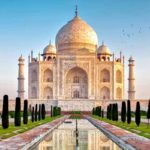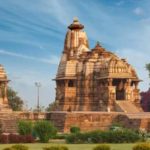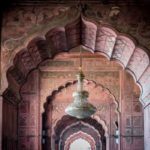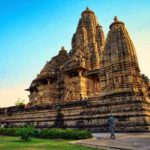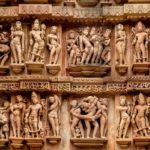Heritage Sites in Madhya Pradesh, the heart of India, is a repository of ancient history, heritage and culture. Here, one can find man-made caves adorned with paintings dating back to thousands of years. The echoes of the royal past can be heard in its fabulous monuments, and the beauty of nature witnessed in its wildlife sanctuaries, parks and hill stations. the heart of India – Madhya Pradesh is acknowledged as a quintessential hub of heritage sites from the bygone era.
The central state of India not only reflects the architectural brilliance of ruling empires but also takes us back to the golden age of India. Dotted with ancient temples, Heritage Sites in Madhya Pradesh, forts, caves, palaces, and more, the wide terrain of Madhya Pradesh offers more than eyes can meet.
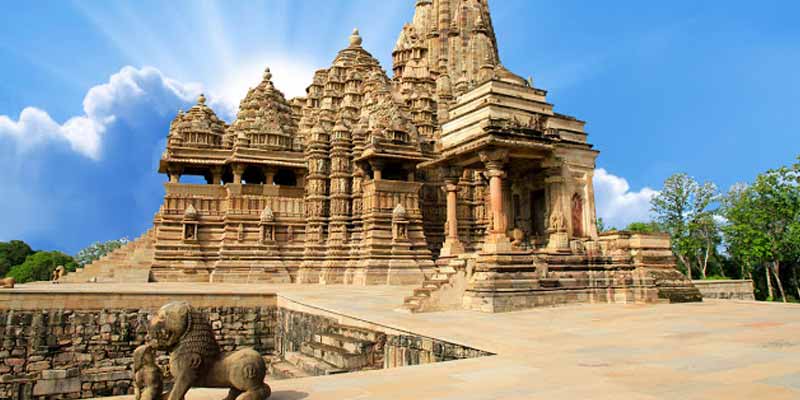
Khajuraho Group of Monuments
Khajuraho, the ancient Kharjjuravahaka, is located in the State of Madhya Pradesh and was the principal seat of authority of the Chandella rulers who adorned it with numerous tanks, scores of lofty temples of sculptural grace and architectural splendour. Yasovarman (A.D. 954) built the temple of Vishnu, which is now famous as Lakshmana temple, and is an ornate and evolved example of its time proclaiming the prestige of the Chandellas. Temples of Khajuraho are world famous for their architectural art and have been declared Heritage Sites in Madhya Pradesh.
The Visvanatha, Parsvanatha and Vaidyanatha Temples belong to the time of king Dhanga, the successor of Yasovarman. The Jagadambi, Chitragupta, are noteworthy among the western group of royal temples of Khajuraho. The largest and grandest temple of Khajuraho is the immortal Kandariya Mahadeva, which is attributed to king Ganda (A.D. 1017-29). The other examples that followed viz., Vamana, Adinatha, Javari, Chaturbhuj and Duladeo, are smaller but elaborately designed.
The Khajuraho group of temples is noted for lofty terraces (jagati) and functionally effective plans. The sculptural embellishments include, besides the cult images; parivara, parsva, avarana devatas, dikpalas, the apsarases and sura-sundaris, which win universal admiration for their delicate, youthful female forms of ravishing beauty. The attire and ornamentation embrace the winsome grace and charm.
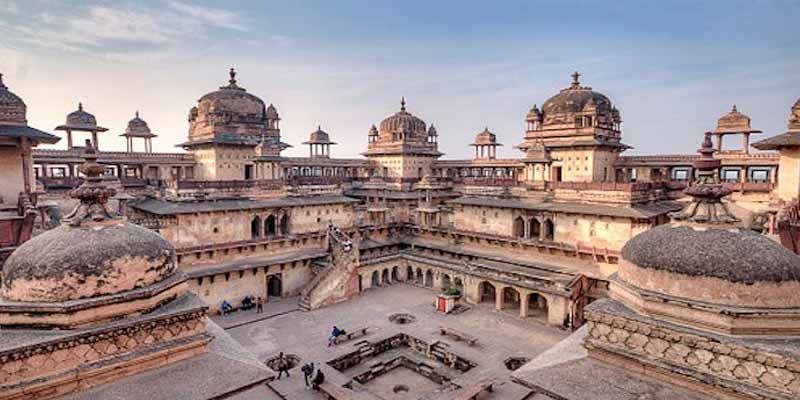
Orchha Fort Complex
Home to a cluster of ancient monuments comprising forts, palaces, temples, and other edifices, Orchha Fort Complex is one of the most famous heritage sites of Madhya Pradesh that attracts tourists from all over the world. Located in the Niwari district of Madhya Pradesh, Orchha is just about 18 km from Jhansi. Built-in the 16th century, Orchha Fort was established during the reign of Rudra Pratap Singh Bundela who was the famous Rajput ruler of his era. Offering tourist attractions such as Jahangir Mahal, Sheesh Mahal, Raja Mahal, Phool Bagh, Rai Praveen Mahal, etc, the architectural splendor of Orchha heritage sites reflects the glory of Bundela Rajputs which is absolutely a feast for eyes Heritage Sites in Madhya Pradesh.
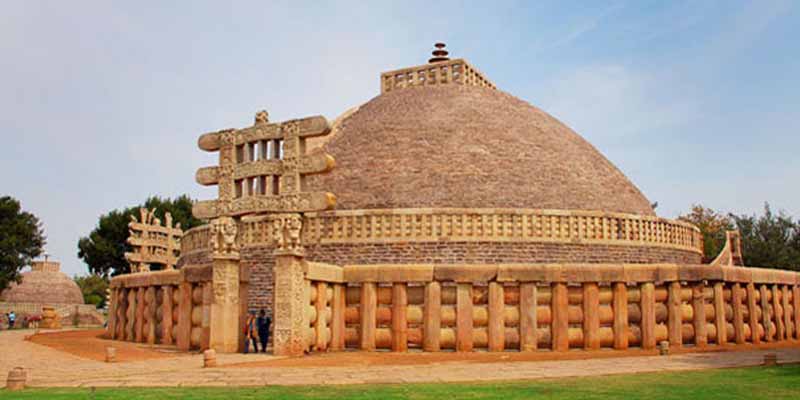
Sanchi Stupa
One of the oldest stone structures in India, Sanchi Stupa is a famous Buddhist complex that was built in 262 BC by the great Mauryan emperor, Ashoka. Preserved under Heritage Sites in Madhya Pradesh, Sanchi Stupa is also the most prominent pilgrimage site for Buddhists. Sanchi Stupa, being the most significant along with Sonari, Satdhara, Andher, and Murelkhurd forms the Buddhist Circuit in Madhya Pradesh. Perched on the hilltop, the great Stupa of Sanchi is located in the Raisen District of Madhya Pradesh which is about 46kms from Bhopal. The elaborately carved gateways that depict Buddhist symbols and scenes from Buddha’s life are the major attractions of Sanchi Stupa that draws a massive footfall of tourists and spiritual seekers.
Gwalior Fortress
The famous Gwalior Fort is among the most visited Heritage Sites in Madhya Pradesh that is famous for its majestic structure and architectural brilliance. The major attractions of Gwalior Fortress are Gujari Mahal, Dravidian style shrine – Teli-Ka-Mandir, Man Mandir Palace, Assi Khamba Ki Baoli, Karan Palace, the Jahangir Mahal, and Shahjahan Mahal. You can also visit the Tomb of Tansen and pay homage to the greatest musician of India who was also one of the nine gems of the Mughal court. With the history of Mughals, Marathas, and Scindias, the Gwalior Fort complex depicts a blend of various art forms practiced during different empires.
Bhimbetka Rock Shelters
Bhimbetka rock shelters, series of natural rock shelters in the foothills of the Vindhya Range, central India. They are situated some 45 km south of Bhopal, in west-central Madhya Pradesh state. Discovered in 1957, the complex consists of some 700 shelters and is one of the largest repositories of prehistoric art in India. The shelters were designated a UNESCO World Heritage site in 2003. The complex is surrounded by the Ratapani Wildlife Sanctuary.
The Bhimbetka region is riddled with massively sculpted formations in the sandstone rock. On the Bhimbetka site’s hill alone, where the bulk of the archaeological research has been concentrated since 1971, 243 shelters have been investigated, of which 133 contain rock paintings. In addition to the cave paintings, archaeologists have unearthed large numbers of artifacts in the caves and in the dense teak forests and cultivated fields around Bhimbetka, the oldest of which are Acheulean stone tool assemblages Heritage Sites in Madhya Pradesh.
The paintings, which display great vitality and narrative skill, are categorized into different prehistoric periods. The oldest are dated to the Late Paleolithic Period (Old Stone Age) and consist of large linear representations of rhinoceroses and bears. Paintings from Mesolithic (Middle Stone Age) times are smaller and portray, in addition to animals, human activities. Drawings from the Chalcolithic Period (early Bronze Age) showcase the early humans’ conceptions of agriculture. Finally, the decorative paintings dating to early historical times depict religious motifs, including tree gods and magical sky chariots.
Udayagiri Caves
Situated in Sonpura and Udayagiri villages of Vidisha district, Udayagiri Caves is a famous heritage site in Madhya Pradesh that houses a group of 20 temples and monasteries from the Mauryan Empire. Carved out of a rocky hill, the temples and monasteries found in Udayagiri contain iconography of Vaishnavism, Shaktism, and Shaivism. These historical caves dedicated to Jainism and Hinduism are significant heritage sites in Madhya Pradesh that give a glimpse to sculptures and art from the Mauryan dynasty Heritage Sites in Madhya Pradesh.
Bateshwar Temples
One of the most spectacular heritage sites in Madhya Pradesh, Bateshwar Temple Complex, about 45 minutes from Gwalior boasts around 200 small and big temples that were constructed during the mid-eighth to the 11th centuries under the reign of the Gurjara-Pratihara dynasty. According to historians, the earthquakes during the 13th-century destroyed this massive temple complex which was later restored under the Archeological Survey in 1920 Heritage Sites in Madhya Pradesh.
However, until the 20th century, the entire complex was under the control of local dacoits and it was in 2002 when K.K. Mohammed, a renowned ASI archeologist saught permission from the local dacoit leader and began restoration work of these marvelous temples that have erotic carvings akin to the famous Khajuraho temples. The temple complex is now open for visitors and people can catch a sight of this huge temple complex anytime during the day.

